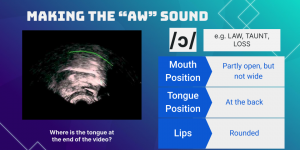This lesson plan and set of slides were presented as part of the fourth course in the second 2021 cohort of LCC's TESOL Diploma program on teaching pronunciation. The pronunciation unit utilized the International Phonetic Alphabet and focused on drills using minimal pairs.
The sounds I was assigned were the vowels in "law-low-allow" (“aw” (/ɔ/), “oh” (/oʊ/), and “ow” (/aʊ/)).
The lesson plan is published here under a CC BY-NC-SA license. This means you are free to use the lesson plan as is or with adaptations so long as this use is non-commercial and you publish your version with the same licensing.
Click here for the PDF of the lesson plan: Lesson Plan.
The lesson plan includes: the presentation with drills, an oral activity game, a written exercise, and a free communicative activity as well as the associated worksheets.
The slides file is too large to be posted here. For the slides and an editable copy of this lesson plan, please contact me at the details given on my resume page. The details are in an image that does not have alt text to prevent bot scraping. You can also reach me via LinkedIn.
For these slides I used a presentation template provided by Slidesgo, which includes icons from Flaticon and Freepik. The lesson plan and slides were built in Google Drive using Google Docs and Google Slides. Icons and images used in the presentation are cited on the slides they first appear; they are all attribution licenses.

The first time I presented this lesson plan, it was too complicated. I tried to show how to read the vowel chart for the IPA and spent too much time explaining mechanics over letting students practice. Here is my self-reflection from the first run:
Good/Effective
- The Aw/Oh/Ow examples did a good job highlighting how the different sounds make a difference.
- Adapted well to audio not playing on students’ end.
- The sound check examples (load/down/crow) did their job from my perspective.
To Be Improved
- Explanation of IPA vowel chart was clear but unnecessary for the present assignment.
- Giving more time for students to practice
- Time management
I asked my TESOL instructor for another chance to present my lesson plan and simplified it much more, allowing time for drills and removing elements that didn't help my lesson objectives. From this experience I learned how to be constructive with my self-reflection without being hypercritical. I was able to present a much smoother presentation that I felt better reflected my capabilities when it comes to teaching and bounce back from the initial disappointment. As a teacher, sometimes activities you think will be helpful need to be cut out or don't go to plan. Being able to take in that information and adapt is a crucial skill that I must build on.